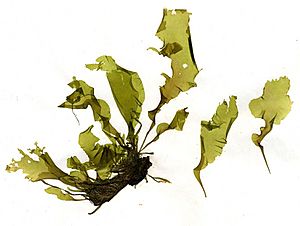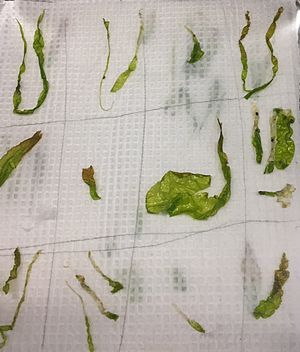Ulva linza facts for kids
Quick facts for kids Ulva linza |
|
|---|---|
 |
|
| Scientific classification | |
| Genus: |
Ulva
|
| Species: |
linza
|
| Synonyms | |
|
|
Ulva linza is a type of green alga, which is like a simple plant that lives in water. It belongs to the Ulvaceae family. You can find this green alga in places like the British Isles.
Contents
What is Ulva Linza?
Ulva linza is a bright green alga that often grows in groups. It can look like tubes or flat strips. This alga can grow up to 30 centimetres (12 in) long, and sometimes even 45 centimetres (18 in). Its main body, called a thallus, is usually not branched. It often has wavy or "frilled" edges, like a ruffle.
The middle part of its body can be wider than its base, sometimes up to 5 centimetres (2.0 in) across. Its ruffled parts are about 1–4 centimetres (0.39–1.57 in) long. The tiny cells that make up Ulva linza are very small, only about 10–15 micrometres (0.00039–0.00059 in) wide.
Where it Lives and Grows
Ulva linza can live in many different kinds of water. It can handle a wide range of saltiness and water quality. Scientists have done tests that show it can grow well in different amounts of light, temperatures, and salt levels. It also doesn't mind if there are different amounts of nutrients like nitrogen and phosphorus in the water. This makes it a very tough and adaptable alga!
How Ulva Linza Reproduces
Ulva linza has two main ways to make new algae. It can reproduce sexually or asexually. This means it can create new algae by combining cells (sexual) or by simply making copies of itself (asexual).
It releases tiny spores from its body. Some spores have two tails (called flagella), and others have four tails. The spores with four tails quickly stick to surfaces. The spores with two tails can be female, male, or asexual spores that will grow into new algae on their own.
Green Tides
Sometimes, Ulva species, including Ulva linza, grow very quickly and cover large areas of water. This is often called a "green tide." These green tides happen because the algae grow very fast, especially when there are a lot of nutrients in the water.
These extra nutrients, like nitrogen and phosphorus, can come from things like water running off farms, sewage flowing into the ocean, or natural ocean currents bringing nutrients to the surface. When there are too many nutrients, the algae can grow out of control.
Where Ulva Linza is Found
Ulva linza lives in coastal areas. You can find it in the littoral zone (the area between high and low tide) and the sublittoral zone (just below the low tide mark). It often grows in muddy bays, attached to small stones or docks. You might also see it on rocks or in rock pools.
This alga has been found in many places around the world. Some examples include Wembury beach in the UK, Narragansett Bay in Rhode Island, the British Isles, and China.
Uses of Ulva Linza
Ulva linza is useful in a few ways:
- Food and Cosmetics: It is edible, meaning people can eat it! It's also used in some cosmetic products.
- Science Research: Scientists use Ulva linza to study something called "biofouling." Biofouling is when living things, like algae, grow on surfaces that are in water, such as the bottoms of ships. Ulva linza is often found growing on man-made structures in the ocean, like ship hulls.



